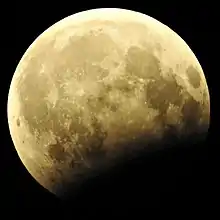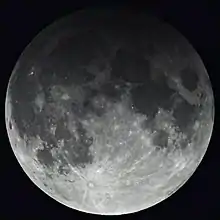November 2021 lunar eclipse
A partial lunar eclipse occurred on 19 November 2021. The eclipse occurred towards a micromoon.[2] This was the longest partial lunar eclipse since 18 February 1440, and the longest until 8 February, 2669; however, many eclipses, including the November 2022 lunar eclipse, have a longer period of umbral contact at next to 3 hours 40 minutes.[3] It was often referred to as a "Beaver Blood Moon" although not technically fulfilling the criteria for a true blood moon (totality).
| Partial eclipse | |||||||||||||
_(cropped).jpg.webp) Starkville, Mississippi at maximum, 9:03 UTC | |||||||||||||
| Date | 19 November 2021 | ||||||||||||
|---|---|---|---|---|---|---|---|---|---|---|---|---|---|
| Gamma | -0.4552[1] | ||||||||||||
| Magnitude | 0.9742[1] | ||||||||||||
| Saros cycle | 126 (46 of 72[1]) | ||||||||||||
| Partiality | 208 minutes, 23 seconds[1] | ||||||||||||
| Penumbral | 361 minutes, 29 seconds[1] | ||||||||||||
| |||||||||||||
This lunar eclipse was the second of an almost tetrad, the others being 26 May 2021 (T), 16 May 2022 (T) and 08 Nov 2022 (T).
Visibility
In northern and western Europe and the westernmost parts of Africa, the first phase of the eclipse was visible, as the Moon set below the horizon on the morning of Friday, 19 November 2021. The fullest extent of the lunar eclipse was visible over North and South America after midnight on Friday, with the event beginning in the latest hours of Thursday night over parts of Alaska and Hawaii. The entirety of the eclipse, from one side of the Earth's shadow to the other, occurred with the Moon visible above the horizon in nearly all of North America.[4]
In the Eastern Hemisphere, as the partially-eclipsed Moon began to rise at dusk, the eclipse became visible across the Pacific Ocean, Australia, and much of Asia. At places in extreme northern latitudes and areas in northern and eastern Russia, such as Kamchatka, the Moon was already visible by the time the eclipse began on Friday (and the eclipse ended just near Saturday midnight). There was little or no visibility for most of Africa, eastern Europe, and western or southern parts of Asia, including the Middle East and much of the Indian subcontinent.[5]
  |
 Visibility map |
Observations
 Madrid, Spain, 7:29 UTC
Madrid, Spain, 7:29 UTC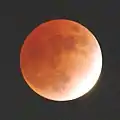 Nara City, Japan, 8:51 UTC
Nara City, Japan, 8:51 UTC Toronto, Ontario, 8:53 UTC
Toronto, Ontario, 8:53 UTC New Plymouth, New Zealand, 9:03 UTC
New Plymouth, New Zealand, 9:03 UTC Santa Fe, New Mexico, 9:03 UTC
Santa Fe, New Mexico, 9:03 UTC Jayapura, Indonesia, 9:04 UTC
Jayapura, Indonesia, 9:04 UTC_(cropped).png.webp) Mexico City, Mexico, 9:08 UTC
Mexico City, Mexico, 9:08 UTC Killingly, Connecticut, 9:12 UTC
Killingly, Connecticut, 9:12 UTC Dayton, Ohio, 9:25 UTC
Dayton, Ohio, 9:25 UTC Hefei, China, 10:35 UTC
Hefei, China, 10:35 UTC Eclipse progression as seen from Texas
Eclipse progression as seen from Texas- Weifang, China, taken began at 10:31 UTC
Related eclipses
Other eclipses of 2021
Lunar year series
| Lunar eclipse series sets from 2020–2023 | ||||||||
|---|---|---|---|---|---|---|---|---|
| Descending node | Ascending node | |||||||
| Saros | Date | Type Viewing |
Gamma | Saros | Date Viewing |
Type Chart |
Gamma | |
111 |
2020 Jun 05 |
Penumbral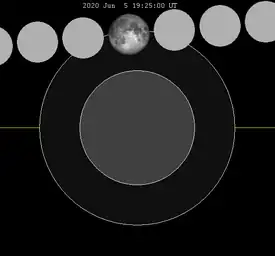 |
1.24063 | 116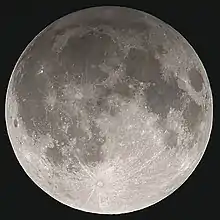 |
2020 Nov 30 |
Penumbral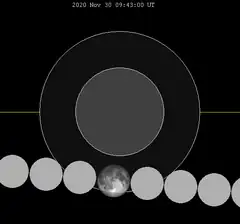 |
−1.13094 | |
121 |
2021 May 26 |
Total |
0.47741 | 126_(cropped).jpg.webp) |
2021 Nov 19 |
Partial |
−0.45525 | |
131_(cropped).jpg.webp) |
2022 May 16 |
Total |
−0.25324 | 136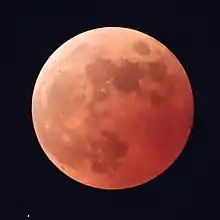 |
2022 Nov 08 |
Total |
0.25703 | |
141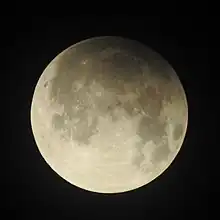 |
2023 May 05 |
Penumbral |
−1.03495 | 146 | 2023 Oct 28 |
Partial |
0.94716 | |
| Last set | 2020 Jul 05 | Last set | 2020 Jan 10 | |||||
| Next set | 2024 Mar 25 | Next set | 2024 Sep 18 | |||||
Tritos series
The tritos series repeats 31 days short of 11 years at alternating nodes. Sequential events have incremental Saros cycle indices.
This series produces 20 total eclipses between April 24, 1967 and August 11, 2185, only being partial on November 19, 2021.
| Tritos eclipse series (subset 1901–2087) | ||||||
|---|---|---|---|---|---|---|
| Descending node | Ascending node | |||||
| Saros | Date Viewing |
Type chart |
Saros | Date Viewing |
Type chart | |
| 115 | 1901 Oct 27 |
Partial |
116 | 1912 Sep 26 |
Partial | |
| 117 | 1923 Aug 26 |
Partial |
118 | 1934 Jul 26 |
Partial | |
| 119 | 1945 Jun 25 |
Partial |
120 | 1956 May 24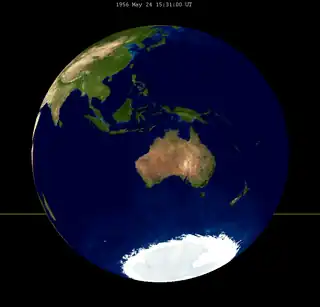 |
Partial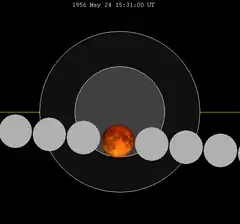 | |
| 121 | 1967 Apr 24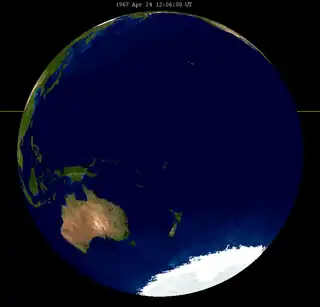 |
Total |
122 | 1978 Mar 24 |
Total | |
| 123 | 1989 Feb 20 |
Total |
124 | 2000 Jan 21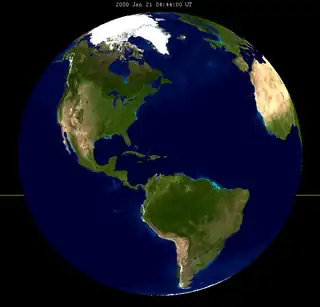 |
Total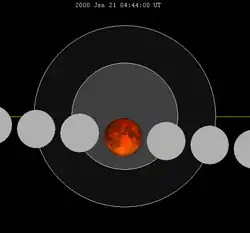 | |
| 125 | 2010 Dec 21 |
Total |
126 | 2021 Nov 19 |
Partial | |
| 127 | 2032 Oct 18 |
Total |
128 | 2043 Sep 19 |
Total | |
| 129 | 2054 Aug 18 |
Total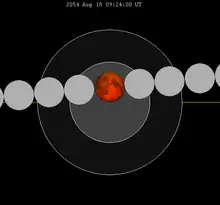 |
130 | 2065 Jul 17 |
Total | |
| 131 | 2076 Jun 17 |
Total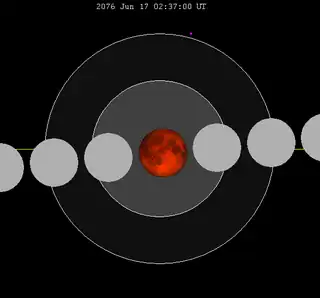 |
132 | 2087 May 17 |
Total | |
| 133 | 2098 Apr 15 |
Total | ||||
Saros series
It is part of saros series 126.
Lunar saros series 126, repeating every 18 years and 11 days, has a total of 70 lunar eclipse events including 14 total lunar eclipses. Solar Saros 133 interleaves with this lunar saros with an event occurring every 9 years 5 days alternating between each saros series.
First penumbral lunar eclipse: 18 July 1228
First partial lunar eclipse: 24 March 1625
First total lunar eclipse: 19 June 1769
First central lunar eclipse: 11 July 1805
Greatest eclipse of the lunar saros 126: 13 August 1859, lasting 106 minutes.
Last central lunar eclipse: 26 September 1931
Last total lunar eclipse: 9 November 2003
Last partial lunar eclipse: 5 June 2346
Last penumbral lunar eclipse: 19 August 2472
1901-2100
11 December 2057
22 December 2075
1 January 2094
Metonic series
- First eclipse: November 20, 2002.
- Second eclipse: November 19, 2021.
- Third eclipse: November 18, 2040.
- Fourth eclipse: November 19, 2059.
- Fifth eclipse: November 19, 2078.
Half-Saros cycle
A lunar eclipse will be preceded and followed by solar eclipses by 9 years and 5.5 days (a half saros).[6] This lunar eclipse is related to two total solar eclipses of Solar Saros 133.
| 13 November 2012 | 25 November 2030 |
|---|---|
 |
 |
Tzolkinex
- Preceded: Lunar eclipse of October 8, 2014
- Followed: Lunar eclipse of December 31, 2028
References
- 2021 Nov 19 chart: Eclipse Predictions by Fred Espenak, NASA/GSFC
- "Longest partial eclipse in centuries bathes Moon in red". www.aljazeera.com. Aljazeera. Retrieved 19 November 2021.
- "What makes certain lunar eclipses so special? (Beginner) - Curious About Astronomy? Ask an Astronomer". curious.astro.cornell.edu. Cornell Astronomy. Retrieved 14 November 2021.
- News, Sa (15 November 2021). "Chandra Grahan 2021: Longest Partial Lunar Eclipse of the Millennium". SA News Channel. Retrieved 19 November 2021.
{{cite web}}:|last=has generic name (help) - Wright, Molly Wasser and Ernie. "An Almost Total Lunar Eclipse". Moon: NASA Science. Retrieved 19 November 2021.
- Mathematical Astronomy Morsels, Jean Meeus, p.110, Chapter 18, The half-saros
External links
- 2021 Nov 19 chart: Eclipse Predictions by Fred Espenak, NASA/GSFC
- Saros cycle 126
